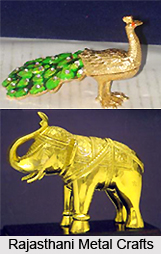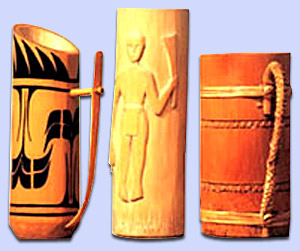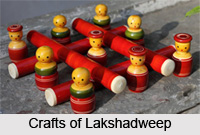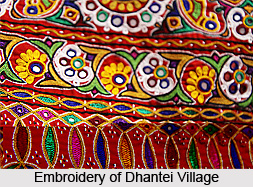 Rajasthani Metal Craft epitomizes the state`s exquisite craftsmanship, showcasing a rich legacy in various mediums. Renowned for its finesse, enameled silver is meticulously crafted into pill-boxes and figurines. Brass enamel, more economical, adorns table-tops with intricate designs featuring dancing peacocks, caparisoned elephants, and ornate swords. A blend of tradition and modernity is evident as wrought iron gains popularity, reflecting contemporary tastes. Rajasthan`s metal artisans seamlessly merge age-old techniques with evolving trends, ensuring the enduring allure of their creations.
Rajasthani Metal Craft epitomizes the state`s exquisite craftsmanship, showcasing a rich legacy in various mediums. Renowned for its finesse, enameled silver is meticulously crafted into pill-boxes and figurines. Brass enamel, more economical, adorns table-tops with intricate designs featuring dancing peacocks, caparisoned elephants, and ornate swords. A blend of tradition and modernity is evident as wrought iron gains popularity, reflecting contemporary tastes. Rajasthan`s metal artisans seamlessly merge age-old techniques with evolving trends, ensuring the enduring allure of their creations.
History of Metal Craft in Rajasthan
The origins of metal craft in Rajasthan can be traced back to the 16th century, when Jaipur was founded as a princely state. Craftsmen known as "thatheras" migrated from the former capital of Amber to Jaipur, where they specialized in creating affordable daily-use items from copper, brass, and tin.
Influenced by Persian and Mughal art styles, Rajasthani metal craft flourished during the Rajputana era, receiving generous patronage from Rajput kings and nobility. This period witnessed a fusion of local craftsmanship with foreign influences, incorporating techniques from Persia and other regions. The result is the distinct style of Rajasthani metal art observed today.
Given the martial nature of the region, the demand for armors surged during the Rajputana era. Rajasthan`s metal craft played a pivotal role in crafting durable armors for both soldiers and kings, along with helmets, swords, spears, pole arms, and various ancient weapons. The craftsmanship extended beyond utility, with golden frames depicting scenes from battles, hunting, and royal events, showcasing vibrant colors and intricate engravings. Even in contemporary times, artisans continue this tradition, employing precision and skill in creating Rajasthani metal crafts, which remain prevalent throughout the state.
Types of Metal Craft in Rajasthan
Rajasthan has been a hub of metal craftsmanship, showcasing remarkable skills in engraving, chasing, and ornamentation of gold and silver articles for everyday and decorative purposes. The metal ware of the region encompasses artistic brass work, along with enameled, engraved, and filigree cut work on silver.
Among the diverse forms of metal craft in Rajasthan, Theva craft stands out as the most popular. In Jaipur, this craft involves engraving in three distinctive styles, namely `Marori` work that features lacquered designs covering the entire surface, `chikan` presents floral ornamentation vividly standing out against a chased and lacquered background, and `bichi` displays a delicate pattern of flowers and leaves on a lacquered surface. These traditional techniques highlight the enduring legacy of Rajasthani metal craft, showcasing a meticulous blend of artistry and craftsmanship.
Theva Craft
In places like Pratapgarh this Theva art has been continuing for ages. By utilizing this technique, the artisans had produced several objects as ornaments and for regular usage as well. This form of metal craft is 400 years old. In ancient India it received royal patronage. During the late 19th and early 20th centuries this metal craft was considered to be a part of enameling.
Theva requires the usage of colored glass for the products. This was one of the reasons why it was seen as a form of enameling. Red, green and blue are the common colors that are used. The glass piece is then encased with a gold-plated silver case. A floral sketch or historical motif is again placed within this frame. A mixture of cinnamon oil and ratti is used to prevent the metal from melting. Apart from these sophisticated art works the metal craft of Rajasthan was put in to use for utility services as well.
Marori Metal Craft
The Marori craft, notably the Chrakwan of Rajasthan, is renowned for its intricate etching on metal surfaces. In this process, artisans meticulously carve detailed designs and fill the grooves with black lac, a resin. The raised ridges of the design create a distinctive visual contrast against the black background. When executed on brass sheets with black lac, it is referred to as Chrakwan. Various colored lacs and metals are also employed in this technique. Artisans from Jaipur, Jodhpur, and Udaipur specialize in Marori work, showcasing their expertise in this traditional metal craft form.
Chikan Metal Craft
The Chikan metal craft is a technique wherein designs are meticulously created on metal surfaces using a sharp tool to cut into the material. In Rajasthan, skilled engravers have attained mastery in this method of metal engraving. This precise and intricate process allows artisans to produce finely detailed patterns and ornamentation on various metal articles. The expertise of Rajasthani craftsmen in Chikan metal craft reflects their dedication to preserving traditional techniques.
Bichi Metal Craft
The Bichi metal craft, a meticulous form of metal engraving, entails crafting minute details such as small leaves and flowers with precision across a lacquered surface. This technique stands out among various metal crafts in Rajasthan due to its emphasis on intricate detailing. Artisans specializing in Bichi craft demonstrate remarkable skill in achieving precision and accuracy, contributing to the distinctive appeal of this traditional form of metal engraving.
Metal Filigree Craft
Metal filigree craft involves the creation of intricate, openwork designs using thin metal wires. Artisans adeptly twist and bend these thin wires to craft delicate jewelry and decorative designs. This technique requires precision and skill, showcasing the craftsmanship of those engaged in metal filigree work. The resulting pieces exhibit a fine balance between intricacy and structural integrity, contributing to the enduring appeal of this traditional craft. In the realm of metalwork, filigree craft stands out for its ability to transform simple wires into elaborate, decorative patterns.
Metal Enamel Craft
Metal enamel craft involves the application of colored glass onto a metal surface. In this technique, a layer of enamel, a form of colored glass, is meticulously applied to the metal surface and subsequently heated to fuse with the metal. This process requires precision and expertise to achieve a seamless integration of color and material. Metal enamel craft is recognized for its ability to enhance the aesthetic appeal of metal objects by introducing vibrant hues and intricate designs.
Etched Metal Craft
Etched metal craft involves a method wherein lines or textures are bitten, or etched, into a metal plate using various mordants, such as acids or chemicals. The process utilizes a metal plate, a ground resistant to acid, and robust press machinery. This technique requires precision in controlling the biting process to create intricate designs on the metal surface. Etched metal craft is known for its ability to produce detailed and fine patterns, showcasing the technical skill and expertise of craftsmen.
Rajasthani Jewelry
Rajasthan`s rich tradition of jewelry crafting spans silver, gold, and diamond pieces, reflecting a blend of contemporary and ethnic styles. Renowned for its diverse jewelry, the state boasts mirrored lac bangles, glass bangles, Kundan, Jadau, Meenakari, Thewa, and more. The streets of Jodhpur and Jaipur are adorned with these intricate pieces. Silver smithy, ranging from anklets to headgear, is an integral part of the craft, reflecting the significant role of silver ornaments in rural communities. The state`s expertise extends to Lac bangles, Kundan, Minakari, enameled gold, uncut diamonds, and emerald-cutting. The exclusive `thewa` from Chittaur is notable for its gold work on glass. Traditional adornments like Rakhdi, Tussi, Baju Bandh, Adah, Gokhrus, and Pajebs showcase the cultural significance of Rajasthani jewelry.
Kundan, a method of setting stones in gold, thrives in Bikaner and Jodhpur. Minakari, the art of enameling in gold and silver, is practiced in Jaipur, Nathdwara, and Pratapgarh. Jaipur`s Johari Bazaar stands out as a global jewelry hub, monopolizing the market with a diverse range. The exclusive Rajasthani tradition of setting precious stones in 22-carat gold, seen in Jaipur and Jodhpur, exemplifies unparalleled design and workmanship.
Different forms of Metal Crafts in Rajasthan
In the realm of metal crafts, Jaipuri engravers have honed their skills in the intricate art of engraving on metal. Lacquered and engraved brassware exhibits a diverse range of articles, including hanging lamps, boxes, bowls, picture frames, and plates. Traditional designs, employing techniques such as hammered, chased, or embossed, feature motifs of flowers, hunting scenes, and landscapes.
Silver craftsmanship in Rajasthan extends to traditional articles like `handas` (water containers), spice bottles, baskets, and trays, enjoying global popularity. White metal articles, with significant export demand, contribute to the state`s prominence in metalwork. Jodhpur specializes in the production of the `badla,` a water carrier made of zinc. The `badlas,` often round, semi-circular, or rectangular, may feature ice chambers and taps, representing a thriving industry in Rajasthan. The art of `Koftagari` or damascening, primarily practiced in Alwar and Jaipur, involves encrusting one metal into another in the form of wire. Noteworthy items include swords, daggers, and shields.
The motifs engraved on these metal frames draw inspiration from various legends and historical narratives, offering insights into the rich history and culture of the state. Depicting important events, some with religious significance, the golden frames serve as historical artifacts. The utilization of vibrant colors and intricate designs distinguishes Rajasthan`s metal crafts, creating a unique aesthetic within the broader Indian context. These crafts serve as captivating pieces for art enthusiasts, showcasing the intersection of history, culture, and artistic craftsmanship in Rajasthan`s metalwork traditions.






